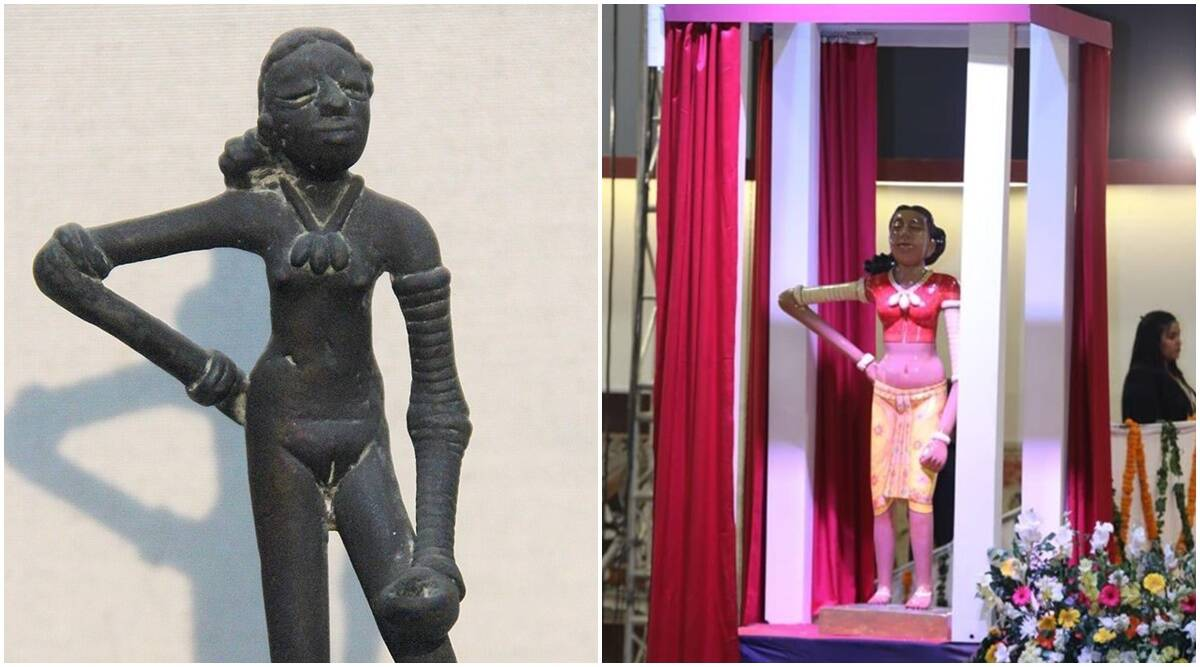Important Facts For Prelims
Dancing Girl Figurine
- 29 May 2023
- 5 min read
Why in News?
A “contemporised” version of Dancing Girl figurine of Mohenjodaro, was used as a mascot for the International Museum Expo 2023 in Delhi. The traditional craft of Channapatna toys, also protected by a GI (geographical indication) tag, was used to create this mascot.
- However, it has recently sparked controversy due to distortion from the original form.
- The Ministry of Culture defended it as an inspired craft work and a contemporary representation of dwarpals or Door Guardian.
What is the Significance of the Dancing Girl Figurine?
- About:
- The Dancing Girl figurine is one of the most famous and iconic artefacts of the Indus Valley Civilization (IVC), also known as the Harappan Civilization.
- It was discovered in 1926 by archaeologist Ernest Mackay at Mohenjodaro, one of the largest and most advanced urban settlements of the ancient world.
- The figurine is made of bronze and was sculpted using the lost wax technique.
- Significance of the Dancing Girl:
- The existence of the figurine indicates the presence of high art in Harappan society, reflecting their artistic sophistication.
- The meticulous craftsmanship and symbolic aesthetic of the Dancing Girl suggest that it was not created for utilitarian purposes but as a symbol of cultural significance.
- The figurine also shows a remarkable sense of realism and naturalism, capturing the subtle details of the girl’s anatomy, expression and posture. Historian AL Basham also praised her lively pertness, distinguishing her from other ancient civilisations' works.
- The existence of the figurine indicates the presence of high art in Harappan society, reflecting their artistic sophistication.
- Current Location of Dancing Girl:
- Despite Mohenjodaro and Harappa becoming part of Pakistan after the Partition, the Dancing Girl remained in India as part of an agreement.
- Today, the bronze figurine is housed in the National Museum of India, captivating visitors in the museum's Indus Civilisation gallery as its "star object."
What is the Lost Wax Technique?
- The process involves creating a wax model of the desired object, which is then encased in a mold. The mold is typically made of a heat-resistant material such as plaster or ceramic.
- Once the mold is created, it is heated to melt and remove the wax, leaving behind a hollow cavity in the shape of the original wax model.
- Molten metal, such as bronze or silver, is then poured into the cavity of the mold, filling the space left by the wax.
- The metal is allowed to cool and solidify, taking the shape of the original wax model. Once the metal has cooled, the mold is broken or otherwise removed, revealing the final metal object.
- The Lost Wax Technique allows for great precision and detail in the final metal casting, as the wax model can be intricately carved or sculpted before being cast. This technique is often used in the creation of sculptures, jewelry, and other decorative metal objects where fine details are desired.
- In contemporary practice, the Lost Wax Technique is often combined with modern technologies such as 3D printing or computer-aided design (CAD) to create the initial wax model, enhancing the precision and efficiency of the process.
UPSC Civil Services Examination Previous Year Question (PYQ)
Q. Which of the following characterises/characterises the people of Indus Civilization? (2013)
- They possessed great palaces and temples.
- They worshipped both male and female deities.
- They employed horse-drawn chariots in warfare.
Select the correct statement/statements using the codes given below:
(a) 1 and 2 only
(b) 2 only
(c) 1, 2 and 3
(d) None of the statements given above is correct
Ans: (b)





